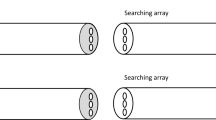Abstract
Insects, birds, and mammals have been shown capable of encoding spatial information in memory using multiple strategies or frames of reference simultaneously. These strategies include orientation to a goal-specific cue or beacon, to the position of the goal in an array of local landmarks, or to its position in the array of distant landmarks, also known as the global frame of reference. From previous experiments, it appears that birds and mammals that scatter hoard rely primarily on a global frame of reference, but this generalization depends on evidence from only a few species. Here we examined spatial memory in a previously unstudied scatter hoarder, the southern flying squirrel. We dissociated the relative weighting of three potential spatial strategies (beacon, global, or relative array strategy) with three probe tests: transposition of beacon and the rotation or the expansion of the array. The squirrels’ choices were consistent with a spatial averaging strategy, where they chose the location dictated by at least two of the three strategies, rather than using a single preferred frame of reference. This adaptive and flexible heuristic has not been previously described in animal orientation studies, yet it may be a common solution to the universal problem of encoding and recalling spatial locations in an ephemeral physical landscape.




Similar content being viewed by others
References
Barkley CL, Jacobs LF (1998) Visual environment and delay affect cache retrieval accuracy in a food-storing rodent. Anim Learn Behav 26:439–447
Berthold P (1991) Orientation in birds. Birkhäuser Verlag,Basel
Biegler R, Morris R (1996) Landmark stability: studies exploring whether the perceived stability of the environment influences spatial representation. J Exp Biol 199:187–193
Brodbeck DR (1994) Memory for spatial and local cues: a comparison of a storing and a nonstoring species. Anim Learn Behav 22:119–133
Cheng K (1994) The determination of direction in landmark-based spatial search in pigeons: a further test of the vector sum model. Anim Learn Behav 22:291–301
Cheng K (1995) Landmark-based spatial memory in the pigeon. In: Medin DL (ed) The psychology of learning and motivation. Academic, New York, pp. 1–21
Cheng K (2005) Goldfish matching geometric and featural cues: a re-interpretation of some of the data of Vargas et al. (2004). J Comp Psychol 119:455–457
Cheng K, Gallistel CR (2005) Shape parameters explain data from spatial transformations: comment on Pearce et al. (2004) and Tommasi and Polli (2004). J Exp Psychol Anim Behav Process 31:254–259
Cheng K, Spetch ML (1998) Mechanisms of landmark use in mammals and birds. In: Healy SD. (ed) Spatial representation in animals. Oxford University Press, Oxford, pp 1–17
Clayton NS, Krebs JR (1994) Memory for spatial and object-specific cues in food-storing and non-storing birds. J Comp Physiol A: Sens Neur Behav Physiol 174:371–379
Essner Jr RL (2002) Three-dimensional launch kinematics in leaping, parachuting and gliding squirrels. J Exp Biol 205:2469–2477
Healy SD, Hurly TA (1998) Rufous hummingbirds’ (Selasphorus rufus) memory for flowers: patterns or actual spatial locations? J Exp Psychol: Anim Behav Proc 24:396–404
Jacobs LF (1995) The ecology of spatial cognition: adaptive patterns of hippocampal size and space use in wild rodents. In: Alleva E, Fasolo A, Lipp H-P, Nadel L. (ed) Studies of the brain in naturalistic settings. Kluwer, Dordrecht, pp. 301–322
Jacobs LF (2003) The evolution of the cognitive map. Brain Behav Evol 62:128–139
Jacobs LF, Schenk F (2003) Unpacking the cognitive map: the parallel map theory of hippocampal function. Psych Rev 110:285–315
Jacobs LF, Shiflett MW (1999) Spatial orientation on a vertical maze in free-ranging fox squirrels (Sciurus niger). J Comp Psychol 113:116–127
Jones LV, Fiske DW (1953) Models for testing significance of combined results. Psychol Bull 50:375–381
Kamil AC, Jones JE (2000) Geometric rule learning by Clark's nutcrackers (Nucifraga columbiana). J Exp Psychol: Anim Behav Proc 26:439–453
Lavenex P, Schenk F (1996) Integration of olfactory information in a spatial representation enabling accurate arm choice in the radial arm maze. Learn Mem 2:299–319
Maaswinkel H, Whishaw IQ (1999) Homing with locale, taxon, and dead reckoning strategies by foraging rats: sensory hierarchy in spatial navigation. Behav Brain Res 99:143–152
Mercer JM, Roth VL (2003) The effects of Cenozoic global change on squirrel phylogeny. Science 299:1568–1572
Papi F (1992) Animal homing. Chapman & Hall, London
Pearce JM, Roberts AD, Redhead ES, Prados J (2000) The influence of passive preexposure on escape from a Morris pool. J Exp Psychol Anim Behav Process 26:186–195
Vargas JP, Lopez JC, Salas C, Thinus-Blanc C (2004) Encoding of geometric and featural spatial information by goldfish (Carassius auratus). J Comp Psychol 118:206–216
Wehner R, Michel B, Antonsen P (1996) Visual navigation in insects: coupling of egocentric and geocentric information. J Exp Biol 199:129–140
Wells-Gosling N (1985) Flying squirrels: Night gliders in the dark. Smithsonian Institution Press, Washington, DC
White NM, McDonald RJ (1993) Acquisition of a spatial conditioned place preference is impaired by amygdala lesions and improved by fornix lesions. Behav Brain Res 55:269–281
Acknowledgements
We would like to thank José Lopez and Ted Claire for constructing the apparatus. The research was supported by a grant from the University Committee on Research to L.F.J. The research followed federal and university animal care, and used rules and guidelines that complied with APA ethical standards in the treatment of animals.
Author information
Authors and Affiliations
Corresponding author
Rights and permissions
About this article
Cite this article
Gibbs, S.E.B., Lea, S.E.G. & Jacobs, L.F. Flexible use of spatial cues in the southern flying squirrel (Glaucomys volans). Anim Cogn 10, 203–209 (2007). https://doi.org/10.1007/s10071-006-0059-y
Received:
Revised:
Accepted:
Published:
Issue Date:
DOI: https://doi.org/10.1007/s10071-006-0059-y




